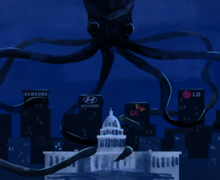AbStranded exhibition’s art and music combination enriches visitors’ experience
Courtesy of David Fulmer
“Prisms and Antiphons” marks the Everson’s first time commissioning pieces of music to accompany works of art.
Get the latest Syracuse news delivered right to your inbox.
Subscribe to our newsletter here.
Nearly one year ago, composer and violinist David Fulmer walked into the Everson Museum of Art and unintentionally discovered a new concert stage.
“At the museum, there were just beautiful sightlines. I could see all of the art and the first thing that came to my mind was, ‘I have to make music here.’ The acoustic is too good. It’s too good,” Fulmer, who works in residence at the Everson, said.
As soon as he got home, he began making calls and sending emails. Fulmer introduced himself to the Everson and presented his idea for a musical addition to their exhibit, “AbStranded: Fiber and Abstraction in Contemporary Art,” which was curated by Elizabeth Dunbar.
After his idea was approved by the Everson, Fulmer commissioned composers to create solo violin pieces that were inspired by the art on display in “AbStranded.” Commissioning composers to create pieces based off of an exhibition on display had never been done before at the Everson.
Fulmer has previously worked with the Museum of Modern Art in New York and the Metropolitan Museum of Art, and he has curated music for a Helen Frakenthaler exhibit. He has also composed works for the New York Philharmonic and conducted groups like the Adelaide Symphony Orchestra and the International Contemporary Ensemble. However, the most important part of this process was finding the right composers for the right works of art, he said. For Fulmer, this was simple.
“It was instantaneous. As soon as I saw (Anne Lindberg’s ‘bloodlines’), I said, Oh, wow, Bahar (Royaee) would write an amazing piece. And I could play it in this space,” Fulmer said.
Another composer Fulmer approached was Vasilikí Krimitzá, who has had her work performed across Europe and the U.S. Krimitzá said she was thrilled to be able to create music for this exhibit and Fulmer.
“First of all, writing for David (Fulmer) is the highest honor for a composer and second of course for this amazing exhibit. I mean, I think I’ve never done this before,” Krimitzá said. “It’s an amazing thing to have the piece played in the Everson Museum as well. It was a big thing for me.”
While the concept of creating music out of art isn’t rare or new — as “Pictures at an Exhibition,” made in 1874 by Modest Mussorgsky, can attest to — performing music that was written in accordance with the art surrounding it is much more rare. Both Fulmer and Alyssa Regent, a graduate student studying composition and conducting at Hunter College who was commissioned by Fulmer, were enthralled by this concept.
“Because music, it’s not something that you can see or something that you can touch,” Regent said. “It’s something that you feel inside. So how do you feel when you come into the room, you see the art, and you feel the music.”
All together, Fulmer commissioned Royaee, Regent and Krimitzá to create solo violin works inspired by different works of art in the show.
For Regent, the works of Julia Bland, an artist who uses a wide variety of materials to create her work, perfectly fit into the style of music she wanted to create. Regent was already working with overlapping elements in her compositions, so she welcomed the challenge with open arms.
“(Art and music) are both connected. And also both separate.David Fulmer, music director and curator of Prisms and Antiphons
“I already had this idea of creating, you know, contrast and at the same time, the mixture of textures and the electronics with the acoustic, so when I saw the work of Julia Bland, I saw how she mixed different textiles and different forms.” Regent said.
On Sept. 18, Regent’s work – along with works from Royaee, Krimitzá, and Johann Sebastian Bach – was performed by David Fulmer in the first edition of “Prisms and Antiphons.” Fulmer’s performance was for an audience of all ages because the museum was hosting a community day. The crowd was captivated by Fulmer’s playing and use of space, said Steffi Chappell, an assistant curator at the Everson.
A month later, “Prisms and Antiphons” was performed again for a very different audience: adults enjoying the wine tasting event held by the Everson. In combining the wine tasting and music, it allowed for new groups of people to experience Fulmer’s performance.
Thursday, the third edition of “Prisms and Antiphons” will be performed by David Fulmer in accordance with another wine tasting the Everson is hosting. It will begin with Bach’s “Partita in D Minor” and be followed by Royaee’s piece as the audience is led to the gallery containing Lindberg’s “bloodlines.”
“My goal with the Everson has really been achieved,” Fulmer said. “We’ve been linking art form and music together, and bringing in new audience members, bringing in new interested parties, and different ages, different demographics and different walks of life, all to enjoy this entanglement.”
Published on November 17, 2021 at 11:58 pm






